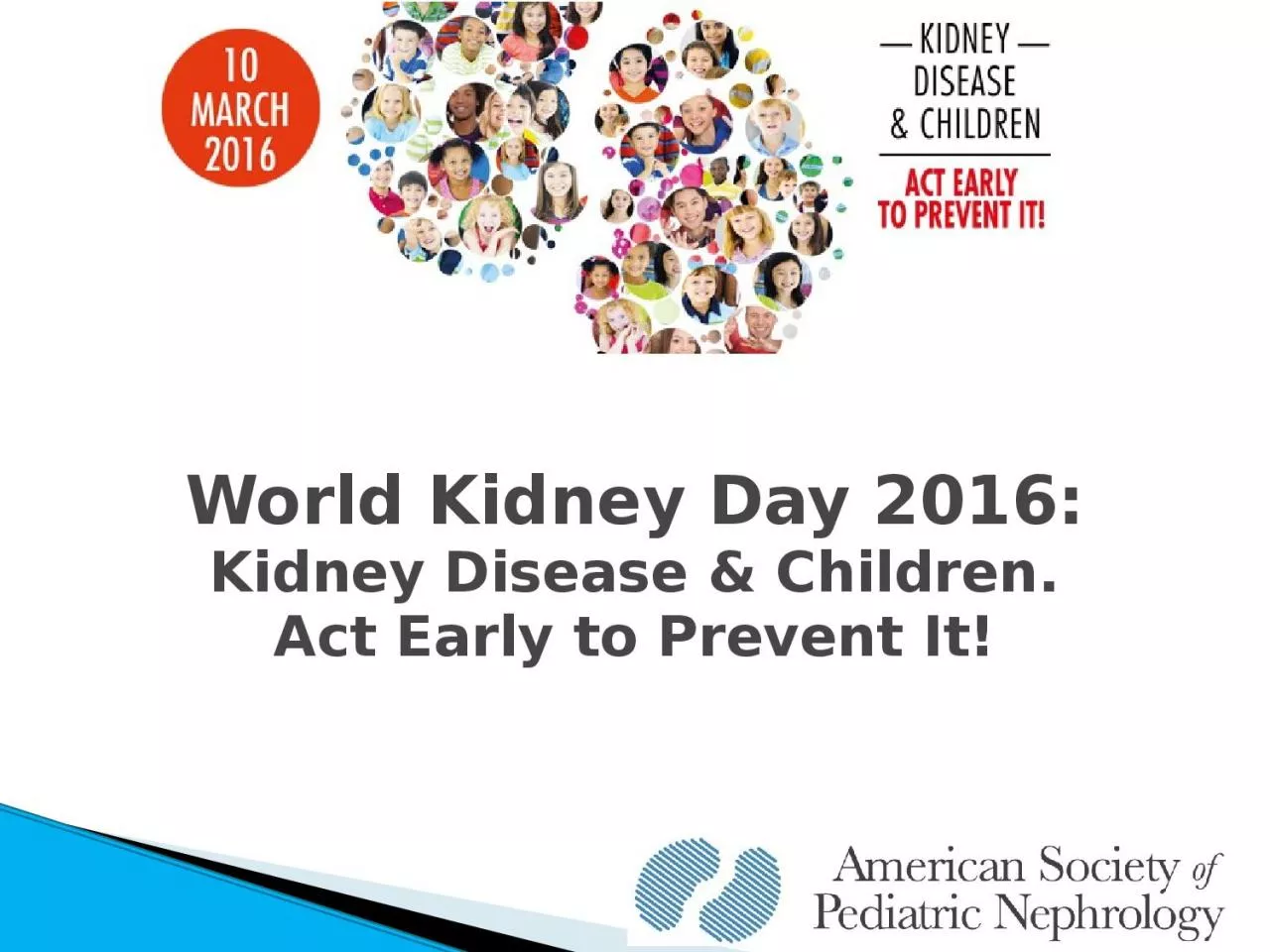

Kidney disease affects millions of people worldwide including many children who may be at risk at an early age It is therefore crucial that we encourage and facilitate education early detection and a healthy life style in children to fight the increase of preventable kidney diseases and ID: 918564
Download Presentation The PPT/PDF document "World Kidney Day 2016: Kidney Disease &..." is the property of its rightful owner. Permission is granted to download and print the materials on this web site for personal, non-commercial use only, and to display it on your personal computer provided you do not modify the materials and that you retain all copyright notices contained in the materials. By downloading content from our website, you accept the terms of this agreement.
Slide1
World Kidney Day 2016:
Kidney Disease & Children. Act Early to Prevent It
!
Slide2Kidney disease affects millions of people worldwide, including many children who may be at risk at an early age. It is therefore crucial that we encourage and facilitate education, early detection and a healthy life style in children, to fight the increase of preventable kidney diseases and to treat children with inborn and acquired disorders of the kidneys worldwide
.
World Kidney Day 2016:
Kidney Disease & Children. Act Early to Prevent It!
Slide3Pediatric Kidney Disease – An Update
Edited by the ASPN Clinical Affairs Committee
Slide4Glomerulonephritis (GN)
Juan
Kupferman
, MD
Albert Einstein School of Medicine
Slide5GN: Background
GN is an important cause of morbidity and mortality in patients of all ages
GN is characterized by glomerular injury and inflammation
GN is defined by the presence of some or all of these
clinico
-biochemical characteristics
Hematuria (always present)
Proteinuria
Edema
Hypertension
Most cases are due to an immunologic response to a variety of etiologic agents
Normal glomerulus
Acute glomerulonephritis
Slide6GN has multiple etiologies and could be primary (affecting only the kidneys) or secondary to a systemic diseaseMost common:
Post-Streptococcal GN (PSGN)
IgA nephropathy (
IgAN
)
Henoch-Schonlein purpura (HSP)
Systemic lupus
erythematosis
(SLE)
GN: Background
Slide7Acute post-Streptococcal GN is the most common glomerulonephritis in childhoodTypically with low complement C3 and evidence of recent
Streptococcal
infectionOther microorganisms can cause similar
findings
IgA nephropathy typically presents with recurrent episodes of gross hematuria
Complement is normal
GN: Background
Normal capillary loop (EM)
Post-Streptococcal GN (EM)
Slide8Henoch-Schonlein purpura nephritis occurs during or after resolution of the acute diseaseSimilar renal histologic findings to IgA nephropathy
Systemic lupus erythematosus can cause focal to diffuse proliferative kidney disease
ANA is positive and
complements C3 and C4
may be decreased
GN: Background
Slide9Specific therapy depends on etiologyTreatment goals Reduce glomerular inflammationInduce and maintain remission of proteinuria
Improve kidney function, if decreased
Control complications due to fluid retention (
i.e.
hypertension, edema)
Therapeutic agents includeAntiproteinuric agents (ACE inhibitors or ARBs)
Fish oil (in IgA nephropathy)
Steroids
Immunosuppresive
agents
Cyclophosphamide
Mycophenolate
mofetilRituximabPlasmapheresisGN: Treatment
Slide10Hematuria could be a risk factor for chronic kidney disease progression in glomerular diseases -Moreno et al. Hematuria. Pediatr Nephrol 2015
Urine biomarkers, such as monocyte chemoattractant protein-1/CCL2 and neutrophil gelatinase-associated
lipocalin
, may be useful tools in the assessment of disease activity in lupus nephritis
-
Abulaban et al. Biomarkers. Curr
Rheumatol
Rep 2015
GN: New developments
Slide11Characterized by glomerular injury and inflammation, often due to an immunologic response to a variety of etiologic agents
There are a variety of immunomodulator therapies that must be tailored to the specific etiology
Novel biomarkers and medications are being developed to enhance our ability to diagnose, predict prognosis, and treat
.
GN: Summary
Slide12Your pediatric nephrology community continues to work hard to improve clinical care, foster education, and advance the science regarding kidney disease in children! We appreciate your support and all you do for children’s health care!
Happy World Kidney Day 2016!